Following figure shows a metal rod PQ resting on the smooth ralls AH and positioned between the poles of a permanent magnet. The rails, the rod and the magnetic field are in three mutual perpendicular directions. A galvanometer G connects the rails through a switch K. Length of the rod 15 cm, B 0.50 T, resistance of the closed loop containing the rod 9.0mΩ. Assume the field to be uniform.
How much power is required (by an external agent) to keep the rod moving at the same speed (=12 cm s−1) when K is closed ? How much power is required when K is open?
Given, length of the rod l=15cm=15×10−2m Magnetic field B=0.50T
Resistance of the closed - loop containing the rod, R=9mΩ=9×10−3Ω
Velocity of rod V=12 cm/s 12×10−2m/s.
To keep the rod moving at the same speed the required power =retarding force × velocity =7.5×10−2×12×10−2=9×10−3W
Topper's Solved these Questions
- BOOK - VIKRAM PUBLICATION ( ANDHRA PUBLICATION)CHAPTER - ELECTROMAGNETIC INDUCTION EXERCISE - Textual Exercise18videos
ELECTROMAGNETIC INDUCTION
- BOOK - VIKRAM PUBLICATION ( ANDHRA PUBLICATION)CHAPTER - ELECTRIC CHARGES AND FIELDSEXERCISE - DAM SURE LAQ1videos
ELECTRIC CHARGES AND FIELDS
- BOOK - VIKRAM PUBLICATION ( ANDHRA PUBLICATION)CHAPTER - ELECTROMAGNETIC WAVEEXERCISE - ADDITIONAL EXERCISES19videos
ELECTROMAGNETIC WAVE
Similar Questions
Fig. 6.05 shows a metal rod PQ resting on the smooth rails AB and positioned between the poles of a permanent magnet. The rails, the rod, and the magnetic field are in three mutual perpendicular directions. A galvanometer G connects the rails through a switch K. Length of the rod = 15 cm, B = 0.50 T, resistance of the closed loop containing the rod = 9.0mΩ. Assume the field to be uniform.
(a) Suppose K is open and the rod is moved with a speed of 12cms−1 in the direction shown. Give the polarity and magnitude of the induced emf.
(b) Is there an excess charge built up at the ends of the rods when K is open ? What if K is closed ?
(c) With K open and the rod moving uniformly, there is no net force on the electrons in the rod PQ even though they do experience magnetic force due to the motion of the rod. Explain.
(d) What is the retarding force on the rod when'K is closed ?
(e) How much power is required (by an external agent) to keep the rod moving at the same speed (=12cms−1) when Kis closed ? How much power is required when K is open ?
(f) How much power is dissipated as heat in the closed circuit? What is the source of this power?
(g) What is the induced emf in the moving rod if the magnetic field is parallel to the rails instead of being perpendicular?
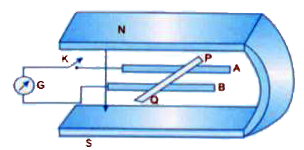 View Solution
View SolutionFig. shows a metal rod PQ resting on the rails A, B and positoned between the poles of a permanent magnet. The rails, the rod and the magnetic field are in three mutually perperdicular directions. A galvanometer connects the rails through a switch K. Length of the rod = 15 cm, B = 0.50 T, resistance of closed loop containing the rod =9.0mΩ Answer the following questions.
(a) Suppose K is open and the rod moves with a speed of 12cm/s in the direction shown, Give the polarity and magnitude of induced e.m.f
(b) Is there on excess charge built up at the ends of rods when K is open ? What if K is closed ?
(c ) With K open and the rod moving uniformly, there is no net force on the electron in the rod PQ even though they do experience magnetic froce due to the motion of the rod Explain.
(d) What is the retarding force on the rod when K is closed?
(e) How much powe s required (by an external agent) to keep the rod moving at the same speed (=12cm/s) when K is closed. (f) How much power is dissipated as heat in the closed circuit ? What is the source of this power?
(g) What is the induced e.m.f. in the following in the moving rod when the permanent magnet is rotated to a vertical position so that the field is parallel to the rails instead of being perpendicular ?
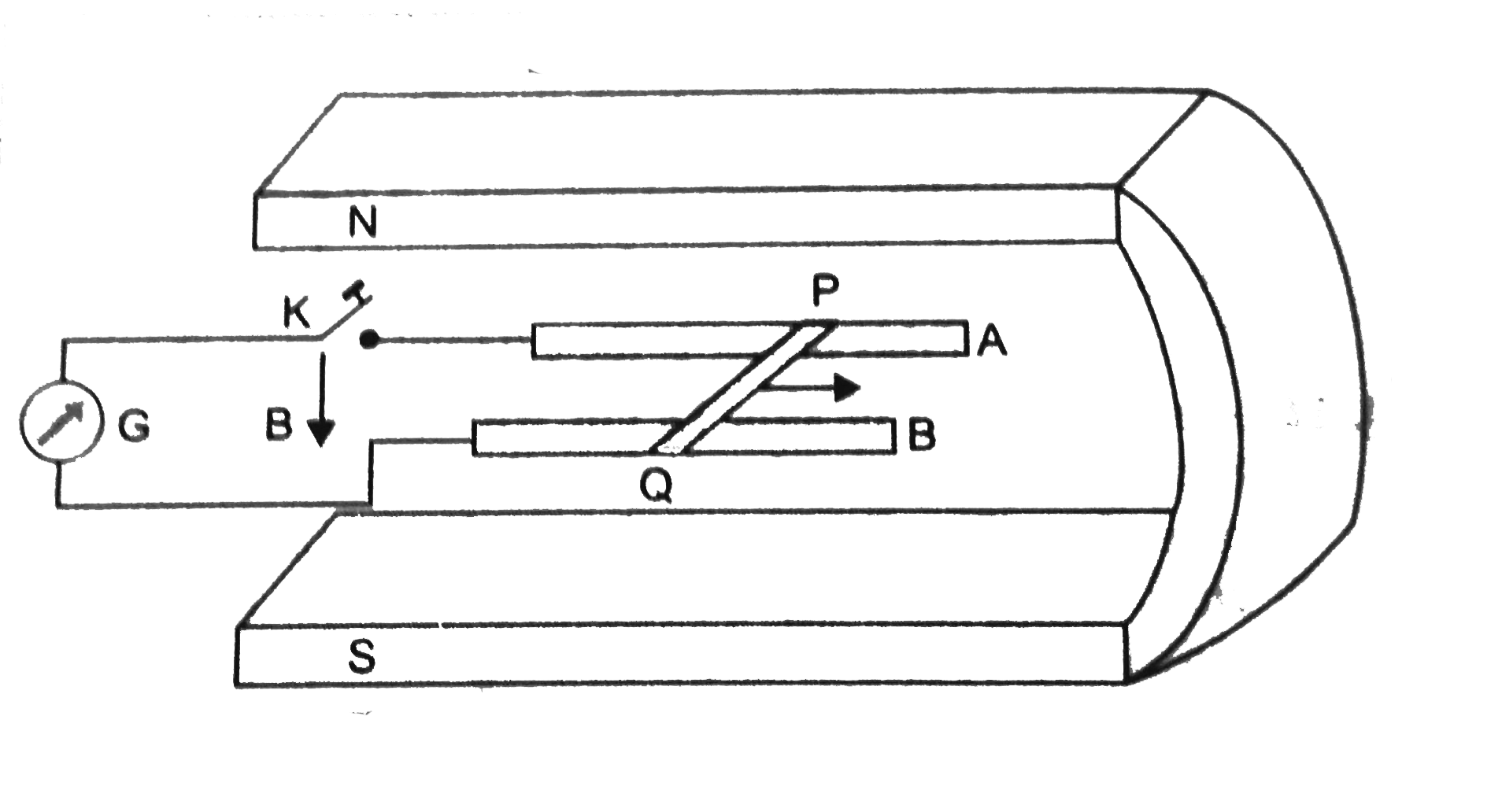 View Solution
View Solution
Knowledge Check
- Question 1 - Select One
A rod PQ is connected to the capacitor plates. The rod is placed in a magnetic field (B) directed downwards perpendicular to the plane of the paper. If the rod is pulled out of magnetic field with velocity →v as shown in Figure.
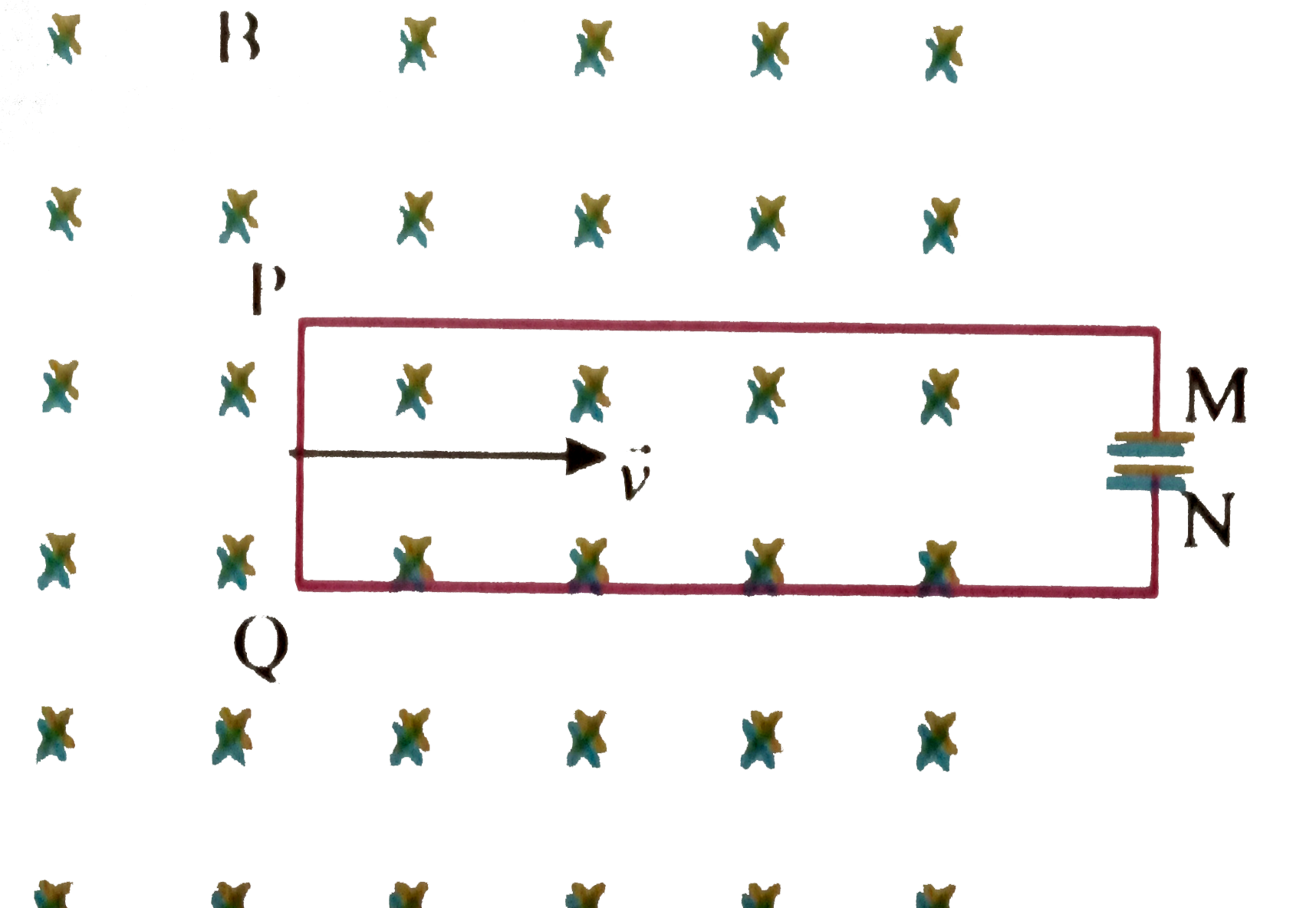 APlate M will be positively chargedBPlate N will be positively chargedCBoth plates will be similarly chargedDno charge will be collected on plates.
APlate M will be positively chargedBPlate N will be positively chargedCBoth plates will be similarly chargedDno charge will be collected on plates. - Question 2 - Select One
A copper rod of mass m slides under gravity on two smooth parallel rails l distance apart set at an angle θ to the horizontal. At the bottom, the rails are joined by a resistance R.
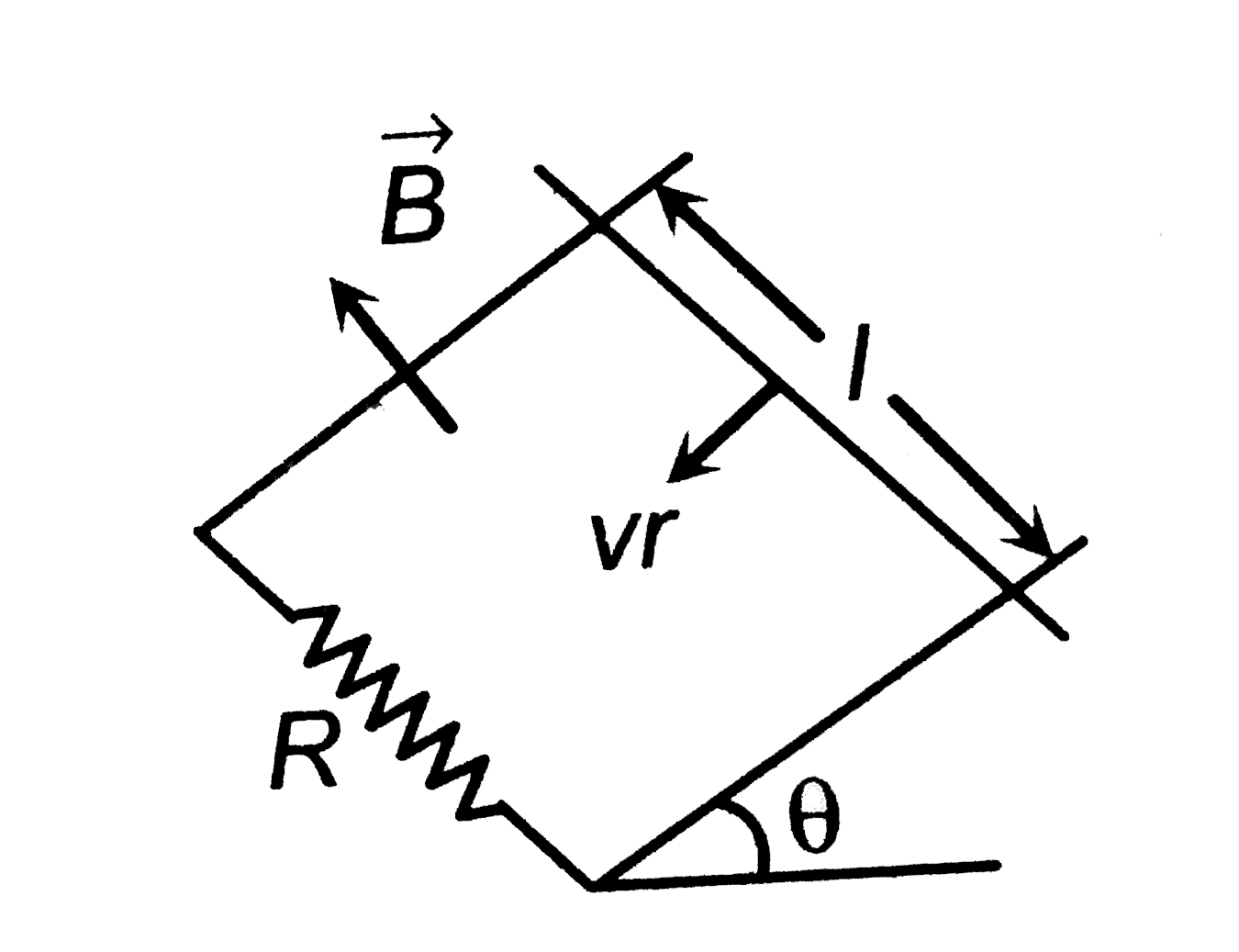
There is a uniform magnetic field perpendicular to the plane of the rails. the terminal valocity of the rod isAmgRcosθB2l2BmgRsinθB2l2CmgRtanθB2l2DmgRcotθB2l2 - Question 3 - Select One
A pair of long, smooth, parallel, horizontal, conducting rails are joined to a cell at one end. There are no external electric or magnetic fields. A metal rod is placed on the rails. The rod will
Aremain stationaryBmove towards the cellCmove away from the cellDoscillate
(a) With the help of a labelled digram, explain the working of a step-up transformer. Give reason to explain the following,
(i) The core of the transformer is laminated.
(ii) Thick copper wire is used in windings.
(b) A conducting rod PQ of length 20 cmn and resistance 0.1Ω rests on two smooth parallel rails of negligible resistance AA' and CC'. It can slide on the rails and the arrangement is positioned between the poles of a permanent magnet producing uniform magnetic field B=0.4T. The rails, the rod and the magnetic field are in three mutually perpendicular directions as shown in the figure. If the ends A and C of the rails are short circuited, find the
(i) external force required to move the rod with uniform velocity v= 10 cm/s, and
(ii) power required to do so.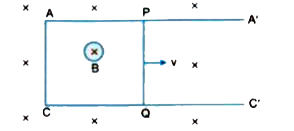 View Solution
View SolutionA rod PQ is connected to the capacitor plates. The rod is placed in a magnetic field (B) directed downwards perpendicular to the plane of the paper. If the rod is pulled out of magnetic field with velocity →v as shown in Figure.
 View Solution
View SolutionA copper rod of mass m slides under gravity on two smooth parallel rails l distance apart set at an angle θ to the horizontal. At the bottom, the rails are joined by a resistance R.

There is a uniform magnetic field perpendicular to the plane of the rails. the terminal valocity of the rod isView SolutionA conducting rod of length is moved at constant velocity v0 on two parallel, conducting, smooth, fixed rails, that are placed in a uniform constant magnetic field B perpendicular to the plane for the rails as shown in Fig. A resistance R is connected between the two ends of the rails.
Then which of the following is/are correct:
 View Solution
View SolutionA conducting rod of length is moved at constant velocity v0 on two parallel, conducting, smooth, fixed rails, that are placed in a uniform constant magnetic field B perpendicular to the plane for the rails as shown in Fig. A resistance R is connected between the two ends of the rails.
Then which of the following is/are correct:
 View Solution
View Solution

